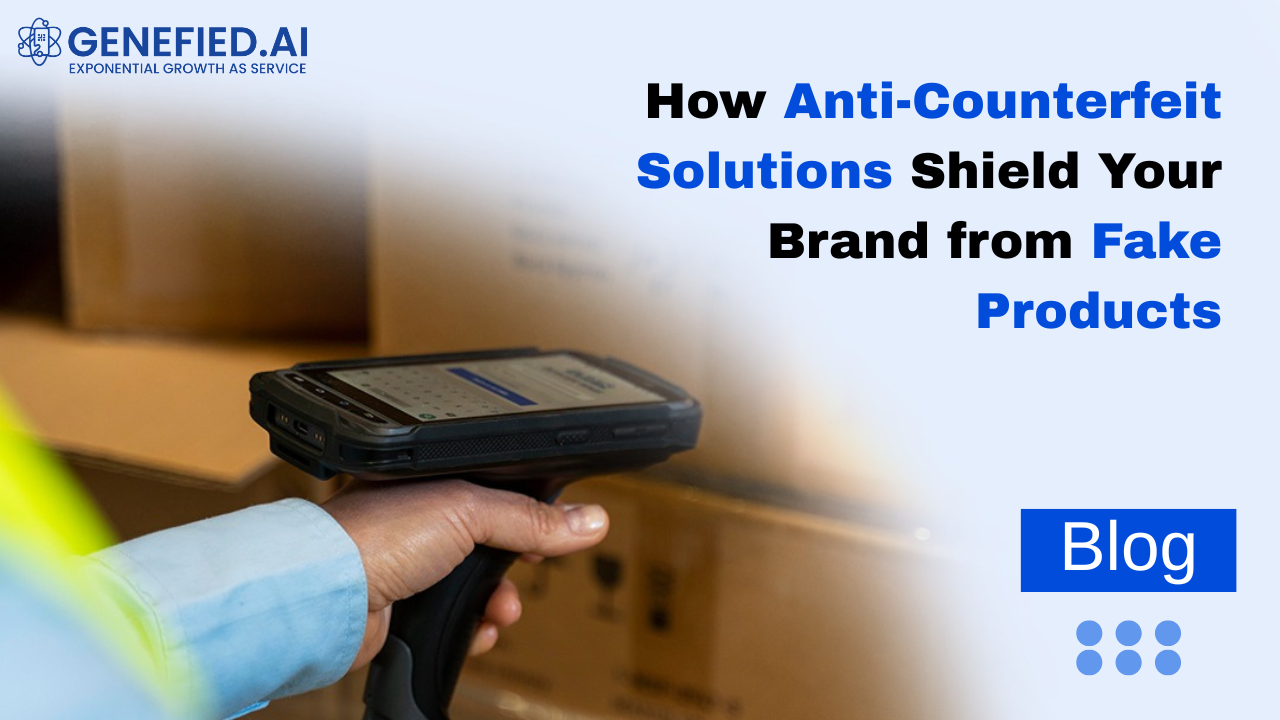Genefied helps Enterprise Brands capture 1st party data to further get insights, retarget and build lookalike audiences.

Anti-Counterfeiting Solution: Imagine this, fake versions of your products flooding the market, stealing your sales, and damaging your hard-earned reputation. This isn't just a problem for luxury brands anymore – every business, big or small, is at risk.
Counterfeit goods don't just hurt your profits, they destroy customer trust. When buyers get low-quality fakes, they blame your brand, not the counterfeiters. Over time, this can crush your reputation and drive customers away for good.
The scary truth? Most companies don't realize how bad it is until they've lost millions. But there's good news. Anti-counterfeiting solutions act like a shield for your business. They help you in spotting fake products quickly, protect your brand's reputation, keep your customers loyal and stop revenue leaks.
Anti-counterfeit solutions refer to technologies, systems, and mechanisms employed to thwart the production, supply, and marketing of counterfeit goods. These solutions assist companies in securing their products and inhibiting unauthorized replication of their products. Through the application of different technologies and mechanisms, firms can verify counterfeit products, secure intellectual property, and ensure that their products are genuine.
Anti-counterfeiting solutions are engineered to create obstacles for counterfeitors in their attempt to replicate a product. Below is how such solutions function:
Anti-counterfeit measures are strongly dependent upon safe and distinct product identifiers. Such identifiers can be QR codes, RFID tags, holograms, or special ink. All these identifiers can be traced back to the originator, so consumers and companies are able to easily check whether a product is authentic or not.
Anti-counterfeiting solutions also utilize tracking technologies to track a product's journey along the supply chain. This can involve real-time location information, which allows companies to verify that their products are making it to valid distributors and not being diverted into black markets.
Digital fingerprints are used in some anti-counterfeiting solutions that are invisible codes placed inside the product or the packaging. Only specialized scanners can detect digital fingerprints, making it very hard for fraudsters to replicate. The solution can even enable customers to scan a product to check its authenticity through their smartphones.
Blockchain is yet another innovative technology that has picked up steam as a means to combat counterfeiting. With blockchain, companies can develop an immutable record that follows every move of a product throughout its life cycle, from production to sale. This provides the product's transparency and authenticity and ensures that no individual can alter the records.
Several companies offer centralized authentication platforms where both manufacturers and consumers can verify the legitimacy of a product. These platforms are user-friendly and typically allow the consumer to enter a product's unique identifier, providing instant confirmation of authenticity.
Anti-counterfeiting solutions assist brands in securing their reputation. Counterfeits have the potential to damage the reputation of a brand, making consumers lose confidence in the quality of the brand. Through proper anti-counterfeiting solutions, companies can assure consumers that they are purchasing genuine products.
As long as consumers can be sure that the products they purchase are authentic, they will continue to buy from the brand. Anti-counterfeiting solutions establish trust and loyalty through a clear and safe method of authentication.
Counterfeit products are likely to be a very expensive problem for business. As well as the direct loss of revenue through counterfeit sales, there is also an investigation and enforcement cost of dealing with counterfeiters. With the help of anti-counterfeit measures, business is able to minimize these cost of sales and guarantee that they are securing profit margins.
Most nations have stringent laws against counterfeiting as well as the marketing of counterfeit goods. Anti-counterfeiting solutions enable companies to follow these laws, preventing possible penalties and fines and ensuring their brand is not entangled with legal issues.
Counterfeit goods generally carry a risk to the safety of consumers. Counterfeit medicines, electronics, and foods, for instance, can be dangerous to health or injurious. Anti-counterfeiting technologies prevent such goods from reaching the market, thus safeguarding consumers from the risk of hazardous products.
These are amongst the most popular anti-counterfeit technologies. Holograms or security stamps are hard to copy and tend to have unique features such as UV marks, color-shifting ink, or serial numbers.
RFID tags are miniature chips that can be inserted into the product or packaging to enable real-time tracking. These tags have product data, which can be read by consumers or retailers to ensure authenticity.
QR codes represent another easy but efficient means of counterfeiting prevention. These codes can be read by the consumers, who are then redirected to a website where they can check the product's legitimacy.
Invisible ink and microtext are technologies applied to label products with invisible markings. Such markings are usually imperceptible to the naked eye but can be read through using special machines, providing added security.
Blockchain technology produces an immutable, tamper-proof record of product data accessible at any time. Every product has a distinct entry, which traces its entire history, from production to delivery.
Although anti-counterfeit solutions have several advantages, their implementation is not without challenges. Such solutions, although effective, may be expensive and complicated to implement. Some of the typical challenges faced by brands when implementing such technologies are:
Anti-counterfeiting technologies, especially cutting-edge technology such as RFID, blockchain, and digital fingerprinting, might have a substantial initial investment. Small and medium-sized enterprises (SMBs) might struggle to budget for such technologies. The long-term advantage, though, of brand protection and preservation of revenue makes the expense worth it.
For most companies, incorporating anti-counterfeiting solutions within current systems is a daunting task. The integration could involve changing or upgrading existing infrastructure, including supply chain management or inventory systems. Incompatibility with existing processes complicates the transition process.
As a company expands, so do the anti-counterfeit measures it implements. With more product to authenticate and multiple geographic locations to consider, it can be problematic to manage product authentication without a simplified, centralized approach. Making certain the technology has scalability in terms of volume and complexity is paramount to its effectiveness.
Even though highly sophisticated anti-counterfeit technologies exist, success with such solutions hinges on consumer awareness. Without awareness among consumers on how to verify products or lack of confidence in the verification process, the value of the solutions is lost. Education and consumer awareness campaigns must be employed to inform customers on the effective use of these solutions.
Along with the advancement in technology, the counterfeiter's tactics also become more advanced. Criminals continually find better ways to replicate products, rendering it difficult for brands to remain ahead. Anti-counterfeit solutions need to be regularly upgraded and modified to defeat these changing threats.
When deploying anti-counterfeit solutions successfully, companies should undertake some best practices to ensure the maximum utilization of these technologies:
The best anti-counterfeit approach is through the employment of a mix of technologies. For instance, the combination of RFID tags and blockchain and holographic labels offers several layers of security. Employing a variety of approaches makes it more challenging for counterfeits to get around the system.
Selection of the right technology supplier is most important. Companies ought to collaborate with specialists and trusted providers of anti-counterfeit solutions with a history of good performance. Such providers are capable of assisting companies in selecting and adopting the most suitable technologies according to their individual requirements and budgets.
A strong consumer education initiative is essential. Companies must invest in educating their consumers on product authenticity checks using the tools offered (QR codes, holograms, etc.). Social media promotions, demonstration at point of sale, and transparent labeling can encourage greater consumer use of anti-counterfeit measures.
Anti-counterfeiting solutions must be regularly reviewed and revised. Brands must monitor the latest trends in counterfeiting and adopt measures accordingly. Continuous auditing and security updates ensure protection mechanisms continue to be effective against the changing nature of counterfeit techniques.
Partnership with regulatory agencies, law enforcement agencies, and industry associations will also enhance anti-counterfeit initiatives. This collaboration will offer legal support for enforcement and prevent the flow of counterfeit products to the market.
As technology gets more advanced, so will anti-counterfeit measures. The future looks bright for such technologies with breakthroughs in artificial intelligence (AI), machine learning, and enhanced encryption techniques leading to more complex and efficient protections.
Artificial intelligence and machine learning programs have the ability to detect counterfeit goods more effectively. AI and machine learning algorithms are able to analyze large volumes of information and identify patterns that can indicate counterfeiting efforts, enabling businesses to react more promptly.
Quantum technology, as nascent as it is, has the potential to completely transform anti-counterfeiting. Quantum encryption can offer the ultimate degree of security, rendering it almost impossible for counterfeiters to copy products or access sensitive product data.
In the future, customers could check whether a product is genuine or not via biometric identification, including facial recognition or fingerprint scanning. This would provide an extra layer of security for final consumers and optimize the overall efficiency of anti-counterfeit solutions.
Smart packaging is yet another innovation that's picking up momentum. With embedded sensors and tamper-evident aspects, smart packaging can offer real-time information on the status of the product and its authenticity, ensuring that it hasn't been compromised during transportation.
Anti-counterfeit solutions play a vital role in brand protection, keeping customers in trust, and authenticating products. Be it sophisticated technologies, such as RFID and blockchain, or easy solutions, such as QR codes and holograms, these solutions make it more challenging for counterfeiters to trick consumers. By investing in anti-counterfeit solutions, companies can protect their reputation, avoid loss of revenue, and guarantee the safety and satisfaction of their customers.
If you're a business owner, it's time to adopt anti-counterfeit measures. Your clients will appreciate it, and your company will remain secure in a more difficult world.


Copyright 2025 Genefied Brand Protection Solutions Pvt. Ltd. All Right Reserved